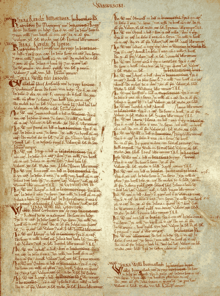Henry de Ferrers

Henry de Ferrers (also known as Henri de Ferrières) was a Norman soldier from a noble family who took part in the conquest of England and is believed to have fought at the Battle of Hastings of 1066 and, in consequence, was rewarded with much land in the subdued nation.
His elder brother William (French: Guillaume) fell in the battle. William and Henri were both sons of Vauquelin de Ferrers (d. ca. 1040) Seigneur of Ferrières-Saint-Hilaire, Eure in Upper Normandy.[2] The Ferrers family holding at Ferrières-Saint-Hilaire was the caput of their large Norman barony.[3]
The landholdings
Henry became a major land holder and was granted 210 manors throughout England and Wales, but notably in Derbyshire[4][5] and Leicestershire,[4] by King William for his conspicuous bravery and support at Hastings.
He first served William I as castellan of Stafford, and in about 1066 or 1067 he was granted the lands in Berkshire and Wiltshire of Goderic, former sheriff of Berkshire, and, by the end of 1068 he also held the lands of Bondi the Staller in present-day Buckinghamshire, Berkshire, Northamptonshire, and Essex. He is thought to have been appointed the first Anglo-Norman High Sheriff of Berkshire.
Following this, in 1070 was the Wapentake of Appletree, which covered a large part of south Derbyshire, granted to Henry on the promotion of Hugh d'Avranches to become Earl of Chester. At the centre of this was Tutbury Castle[6] where he rebuilt and founded the priory in 1080.
His major landholdings, however, were those of the Anglo-Saxon Siward Barn,[7] following a revolt in 1071, including more land in Berkshire and Essex and also Gloucestershire, Warwickshire, Nottinghamshire and Derbyshire.
These included part of the wapentakes of Litchurch and Morleyston, which contained an area later to be known as Duffield Frith. To command an important crossing over the Derwent he built Duffield Castle. In the wapentake of Hamston was the west bank of the River Dove, where he built Pilsbury Castle. Both these were of typical Norman timber motte and bailey construction. The latter history of Pilsbury is unknown, but Duffield was rebuilt as a stone fortress sometime in the Twelfth century.[8]
He was a key administrator in Derbyshire and Staffordshire, and among the most powerful Anglo‑Norman magnates. In 1086 he was a legatus ('commissioner’) on the West Midland circuit of the Domesday survey.
Henry's Family
Henry had by his wife, Bertha, three sons - Enguenulf, William and Robert. A daughter, Amicia, married Nigel d'Aubigny, probably the brother of Henry I's butler. Henry had built Duffield Castle to protect and administer the Frith, and he placed it in the charge of Enguenulf.[9] Meanwhile, William inherited the family's Norman estates. He joined Robert Curthose and was captured at Tinchebrai.
The date of Henry de Ferrers' death is uncertain, but it would seem to be between 1093 and 1100. He was buried in Tutbury Priory.
Enguenulf died shortly afterwards and the English estate passed to Robert, whom King Stephen later made the first Earl of Derby.

Undertenants
As a leading Norman magnate, Henry de Ferrers was followed to England by a coterie of lesser lords, or vassals, who were part of the feudal structure of Normandy and who owed their allegiance to their overlord. Among the underlords who followed Henry de Ferrers were three families who were lords of villages within the original Ferrers barony in Normandy: the Curzons (Notre-Dame-de-Courson),[10] the Baskervilles (Boscherville)[11] and the Levetts (Livet-en-Ouche).[12]
All three families were from villages close by Ferrières-Saint-Hilaire. In the case of the de Livets, the village under their control was approximately four miles from the caput of the Ferrers family barony at Ferrières-Saint-Hilaire.
His grandson, Earl Robert de Ferrers the younger, produced a charter confirming land grants originally made by Henry de Ferrers to his vassals including: Alfinus de Breleford, Nigellus de Albiniaco, Robert fitz Sarle, William de Rolleston, Robert de Dun, Hugh le Arbalaster, Anscelin de Heginton, Robert de St. Quintin.[13]
References
- ↑ Public domain image from Wikimedia Commons accessed May 2007
- ↑ Marios Costambeys, ‛Ferrers, Henry de (d. 1093x1100)’, Oxford Dictionary of National Biography, Oxford University Press, September 2004; online edn, May 2007 61, accessed 28 October 2007
- ↑ The Origins of Some Anglo-Norman Families, David C. Douglas, Lewis C. Loyd, The Harleian Society, Leeds, 1951, Reissued by Genealogical Publishing Co., 1975
- 1 2 Domesday Book: A Complete Translation. London: Penguin, 2003. p. 656-7 744-9 ISBN 0-14-143994-7
- ↑ A listing of Henry's manors in Derbyshire
- ↑ Marios Costambeys, 'Ferrers, Henry de (d. 1093x1100)’, Oxford Dictionary of National Biography, Oxford University Press, September 2004; online edn, May 2007 [ 61, accessed 28 October 2007]
- ↑ Siward Barn fought beside Hereward the Wake at Ely. He held many estates in Derbyshire, Nottinghamshire and further north. Some literature refers to him as Earl of Northumbria. However the Siward who was Earl of Northumbria had died in 1055. The earl at that time was Morcar. There were a number of Siwards at that time. Among the literature there is a reference to Siward Barn the Red and Siward Barn the White, the sons of Osberne Bulax, who could have been the eldest son of the first Siward
- ↑ Turbutt, G., (1999) A History of Derbyshire. Volume 2: Medieval Derbyshire, Cardiff: Merton Priory Press
- ↑ Bland, W., 1887 Duffield Castle: A lecture at the Temperance Hall, Wirksworth Derbyshire Advertiser
- ↑ The Origins of Some Anglo-Norman Families, David C. Douglas, Lewis C. Loyd, The Harleian Society, Leeds, 1951, Reissued by Genealogical Publishing Co., 1971
- ↑ The Origins of Some Anglo-Norman Families, David C. Douglas, Lewis C. Loyd, The Harleian Society, Leeds, 1951
- ↑ The Origins of Some Anglo-Norman Families, David C. Douglas, Lewis C. Loyd, 1951
- ↑ The Victoria History of the County of Derby, William Page, Ed., volume one, 1905, Archibald Constable and Co. Ltd.